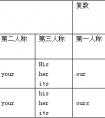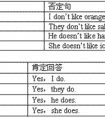句型转换。1. My father lets me go out to play. (改为同义句) My father ________ _______ ________ go out to play.2. I want you to take care of my little brothe-八年级英语
直接引语和间接引语关系:
直接引语:直接引述别人的话(句子中有“”)。
间接引语:用自己的话转述别人的话,叫“间接引语”(句子中一般无“”)
间接引语在大多数情况下是一个宾语从语。直接引语变成间接引语时,要注意以下几点:
人称变化、时态变化、宾语从句要用陈述句语序。
1.直接引语是陈述句,变成间接引语时,由连词that 引导。例如:
She said, "I am very happy to help you."→She said that she was very happy to help you.
2. 直接引语是一般(选择/反意)疑问句,变成间接引语时,由连词whether或if 引导。例如:
He asked me, "Do you like playing football?"→He asked me if/whether I liked playing football.
注意:大多数情况下,if和whether 可以互换,但后有or not,或在动词不定式前,或放在介词后作连接词时,一般只用whether。例如:
She asked me whether he could do it or not.
He hesitated about whether to drive or take the train.
3. 直接引语是特殊疑问句,变成间接引语时,由相应的疑问词who, whom, whose, how, when, why, where 等引导。例如:
My sister asked me, "How do you like the film?"→My sister asked me how I liked the film.
4. 直接引语是祈使句,变成间接引语时,把动词原形变成动词不定式,并在动词不定前加tell, ask, order 等的宾语。例如:
The captain ordered, "Be quiet."→The captain ordered us to be quiet.
注意:此种情况的否定句,在动词不定式前加not。
My teacher asked me, "Don't laugh."→My teacher asked me not to laugh.
一些注意事项:
(1)如果直接引语是表示客观真理时,变为间接引语,一般现在时不改为一般过去时。如:
The teacher said "The earth goes round the sun."
→The teacher said that the earth goes round the sun.
(2)如果直接引语中有明确表示过时间的状语,变为间接引语时,一般过去时不改为过去完成时。如:
He said to me, "I was born in 1973."
→He told me that he was born in 1973.
(3)如果直接引语所述事实在当时和目前同样生效,变为间接宾语时,一般现在时不改为一般过去时。如:
He said, "I'm a boy, not a girl."
→He said that he is a boy ,not a girl.
(4)如果直接引语中的谓语动词表示一种反复出现或习惯动作,
在变为间接引时,一般现在时不改为一般过去时。如:
The girl said, "I get up at six every morning."
→The girl said that she gets up at six every morning.
(5)如果直接引语中含有since, when, while 引导的表示过去时间的状语从句,
在变为间接引语时,只改变主句中的谓语动词,从句的一般过去时则不变。如:
He said to me, "I have taught English since he came here ."
→He told me that he had taught English since he came here.
(6)如果直接引语中含有情态动词 must, need, had better以及情态动词的过去式could, might, should, would,
在变为间接引语时,这些情态动词没有时态的改变。例如:
The teacher said to me . "You must pay more attention to your pronunciation."
→The teacher told me that I must (have to ) pay more attention to my pronunciation.
He said , "I could swim when I was only six ."
→He said that he could swim when he was only six.
(7)间接引语一般要用陈述句的语序,即主、谓、宾的顺序。例如:
He asked Lucy, "Where did you go?"→He asked Lucy where she went.
Tom said, "What do you want, Ann?"→Tom asked Ann what she wanted.
A.一般不表示请求或祈使的句子改为一个宾语从句
1.连词
若直接引语引号里的内容是陈述句,那么改为间接时,要用连词 that (可以省略)
……………….一般疑问句,…….,要用连词 if/whether (不可以省略)
……………….特殊疑问句,…….,要用连词 wh- 即特殊疑问词本身(不可省)
2.变化
(1)主句动词的变化
一般说来,主句谓语动词常为said或said to,变为间接引语时,当直接引语是陈述句时,said不变。
当直接引语是一般疑问句和特殊疑问句时,则要把said或said to变为asked / asked sb.
(2)从句人称的变化
由直接引语变间接引语时,从句的主语人称要遵循一主、二宾、三不变的原则。
①直接引语的主语是第一人称变为间接引语时要和主句的主语保持一致。
②如果直接引语的主语是第二人称变为间接引语时要与主句的宾语保持一致。
③如果直接引语的主语是第三人称变为间接引语时,人称不变。例如:
①They said, “We will go there by bus.” →They said they would go there by bus.
②She said to me, “Are you interested in science?” →She asked me if I was interested in science.
③His mother said to me, “He can't go to school.” →His mother told me that he couldn't go to school.
(3)、从句动词时态的变化
a. 如果主句的时态是一般过去时,从句的时态则应是与主句时态相应的过去时态。
①一般现在时→一般过去时;
②一般过去时→过去完成时;
③现在进行时→过去进行时;
④现在完成时→过去完成时;
⑤过去完成时→过去完成时(不变);
⑥一般将来时→过去将来时。例如:
The girl said, “I'm sorry for being late for class.” →The girl said that she was sorry for being late for class.
b. 直接引语变为间接引语时,如果主句中的谓语动词是一般现在时或一般将来时,则间接引语从句的时态保持不变。例如:
He says, “I have finished my homework.” →He says that he has finished his homework.
She will say, “I'll do it tomorrow.” →She will say that she'll do it the next day.
c. 直接引语如果是客观事实或真理,变为间接引语时,从句时态不变。例如:
The teacher said, “The earth moves around the sun.” →The teacher said that the earth moves around the sun.
(4)、指示代词、时间状语、地点状语和动词的变化
直接引语变为间接引语时,指示代词的变化为this→that, these→those等;
时间状语的变化为now→then, today→that day, yesterday→the day before, tomorrow→the next day等;
地点状语的变化为here→there;动词的变化为come→go(go 不要变come)。例如:
1. She said, “I will come this evening.” →She said that she would go that evening.
2. He said, “My sister was here three days ago, but she is not here now.” →He said that his sister had been there three days before, but she was not there then.
B.表示请求或祈使的句子改为句型tell/ask/order sb (not) to do sth
当直接引语引号里的内容表示要求时用tell sb (not) to do sth
当直接引语引号里的内容表示请求时用ask sb (not) to do sth
当直接引语引号里的内容表示强制要求时用order sb (not) to do sth
考点名称:状语从句
- 状语从句:
指句子用作状语时,起副词作用的句子。它可以修饰谓语、非谓语动词、定语、状语或整个句子。
根据其作用可分为时间、地点、原因、条件、目的、结果、让步、方式和比较等从句。
状语从句一般由连词(从属连词)引导,也可以由词组引起。
从句位于句首或句中时通常用逗号与主句隔开,位于句尾时可以不用逗号隔开。 - 状语从句分类:
1、时间状语从句
常用引导词:
when, as, while, as soon as, while, before, after, since , till, until
特殊引导词:
the minute, the moment, the second, every time, the day,the instant, immediately , directly, no sooner … than, hardly …when, scarcely … when
I didn't realize how special my mother was until I became an adult.
While John was watching TV, his wife was cooking.
The children ran away from the orchard(果园) the moment they saw the guard.
No sooner had I arrived home than it began to rain.
Every time I listen to your advice, I get into trouble.
2、地点状语从句
常用引导词:
where
特殊引导词:
wherever, anywhere, everywhere
Generally, air will be heavily polluted where there are factories.
Wherever you go, you should work hard.
3、原因状语从句
常用引导词:
because, since, as, for
特殊引导词:
seeing that, now that, in that, considering that, given that, considering that, as much as, so much as
My friends dislike me because I'm handsome and successful.
Now that everybody has come, let's begin our conference.
The higher income tax is harmful in that it may discourage people from trying to earn more.
Considering that he is no more than 12 years old, his height of 1.80 m is quite remarkable.
4、目的状语从句
常用引导词:
so that, in order that
- 最新内容
- 相关内容
- 网友推荐
- 图文推荐
| [家长教育] 孩子为什么会和父母感情疏离? (2019-07-14) |
| [教师分享] 给远方姐姐的一封信 (2018-11-07) |
| [教师分享] 伸缩门 (2018-11-07) |
| [教师分享] 回家乡 (2018-11-07) |
| [教师分享] 是风味也是人间 (2018-11-07) |
| [教师分享] 一句格言的启示 (2018-11-07) |
| [教师分享] 无规矩不成方圆 (2018-11-07) |
| [教师分享] 第十届全国教育名家论坛有感(二) (2018-11-07) |
| [教师分享] 贪玩的小狗 (2018-11-07) |
| [教师分享] 未命名文章 (2018-11-07) |


![Sunday is my birthday. I would like _____ a birthday party, would you _____to my party? [ ]A. have; come B. to have; to come C. have; to come D. to have-七年级英语](http://www.00-edu.com/d/file/ks/4/2/budingshi/2020-01-08/smalla85122db0c71d7fb6ae58187be7f1fd11578430330.png)

![Why areyou here? You are supposed ______ in the classroom now. [ ] A. to studyB. to be studiedC. studying D. to be studying -九年级英语](http://www.00-edu.com/d/file/ks/4/2/budingshi/2020-01-08/small6dee02daa62cac1c71853ac804ab4fbd1578422460.png)
![She is very poor. Little food _____ and no room _____! [ ]A. to eat, to live B. to eat, to live in C. eating, living -八年级英语](http://www.00-edu.com/d/file/ks/4/2/budingshi/2020-01-09/small17b77c2697a3ef8f1461d0d14b016ee51578585185.png)
